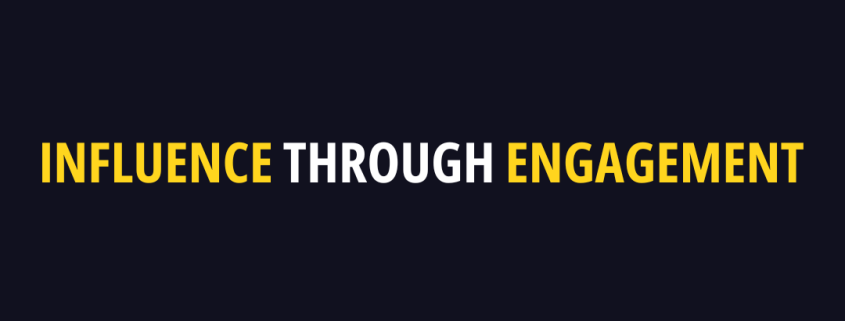Public Speaking: How to create influence through engagement
In public speaking, engagement is the level of attention, interest and interaction you gain from the audience.
It determines how interested the audience are in your message and how deeply they are thinking about what you are saying.
The stronger the engagement with an audience you have, the higher level of influence you will have.
And the more influence you have, the more likely people will reposed to your message the way that you want them to.
Having influence when you are speaking means that you can have an effect on the audiences beliefs, behaviours, attitudes and/or actions.
Influence and engagement are valuable public speaking skills to have if you have a strong message you want to deliver, are speaking to create action or if you are trying to motivate people.
However; you won’t get influence without engagement.
Add some humour.
In my conversation with comedian Stuart Mitchell, he detailed his approach to integrating humour into the speeches and presentations of CEOs and organisational leaders.
He believes that humour serves as the most effective method to establish rapport and captivate an audience
“You need to be engaging, need to address the room, you need an opening line to bring these people on board”
He goes on to state that there is a fine line between bring a joker and adding a few light hearted lines into a speech or presentation to lighten it up a bit.
Using humour creates an emotional response.
When people laugh, they want to laugh more, and if you’ve made them laugh at the very beginning then they’ll be much more engaged throughout the rest of the speech or presentation.
Stuart believes that displaying small elements of self-deprecation or addressing something everyone else is thinking about builds a connection with the audience.
The audience will feel a connection if the speaker lets them in by laughing at themselves a bit or if the speaker has the same thoughts as they have on a particular subject.
When there’s connection, there’s trust.
Where is the relevance?
How relevant is the message you are speaking about to your audience?
If people can’t relate your speech to themselves or their environment, then they’ll switch off.
Being aware of the audience and tailoring your speech and message to them so that it is relevant will generate more engagement.
You can create engagement by using specific language and references that the audience are familiar with.
Referencing recent changes the audience will be familiar with.
Acknowledging the perspectives and feelings that some individuals hold about a particular topic or event demonstrates your awareness and comprehension of the audience’s feelings.
Mind your language
Language plays a huge role in creating engagement.
Too much jargon, abbreviations and technical language can isolate people.
If they don’t understand what you are talking about, they’re going to switch off.
However, don’t patronise your audience either, there’s a fine line between using too much technical talk and then over simplifying it and insulting people’s intelligence.
Understand the power of pronouns.
If I say “we” when talking to an audience, I am making myself part of the group I am speaking to.
If I refer to the audience as “you” then I am separating myself from them.
During my conversation with Dr. Kieran File, a professor specialising in Acquired Linguistics at Warwick University, he emphasised the significance of the pronouns used by sports coaches and managers in their media interviews.
Employing terms such as “you” engages your audience more personally, giving the impression of a direct conversation.
In instances where there may be some resistance from the audience, fostering a sense of unity and inclusivity can be achieved by using collective pronouns like “us” and “we,” thereby enhancing the feeling of solidarity among everyone present.
Ask questions?
Naturally, if people know there’s a chance that they’re going to be asked questions then they’ll be more likely to stay engaged.
So it’s a good idea to set the tone early to make people aware that there is a chance they’ll be asked questions throughout.
There’s nothing worse than asking someone a question and then realising that they’ve completely zoned out and don’t know how to answer.
Not every question has to be directed towards a particular person, and not every question needs an answer.
Letting a question hang in the air to get the audience to ponder and think about something can be enough.
Using questions to get the audience nodding along in agreement shaking their heads in disagreement collectively is another way to create engagement through questions.
Here’s an example of an open question that most people being asked can relate to: “Don’t you just hate when you step into a puddle and feel the water seeping through your socks?”
Create uncertainty.
For most people wanting to build influence, it might seem counterintuitive to deliberately create uncertainty within the audience.
But creating uncertainty can trigger curiosity.
If the audience become curious, they’ll want to find out more.
They’ll lean forward, narrow their eyes, maybe tilt their head to the side and frown slightly.
These are classic signs that someone is engaged in what you’re saying but uncertain, but curious to find out the answer or where this speech is going.
By creating uncertainty in your speech or presentation, you create an interest from the audience to find out more information.
Just make sure that you create uncertainty and then deliver the answers during your speech, you don’t want your audience leaving feeling more uncertain and asking more questions.
Without engagement, your message will be lost on the audience and you won’t have much or any influence on them.
If you want an audience to take action, follow what you say and motivate them to change their minds, attitudes or behaviours you need to be engaged with them.
Create curiosity, ask questions, mind your language and don’t be scared to add a bit of humour.



